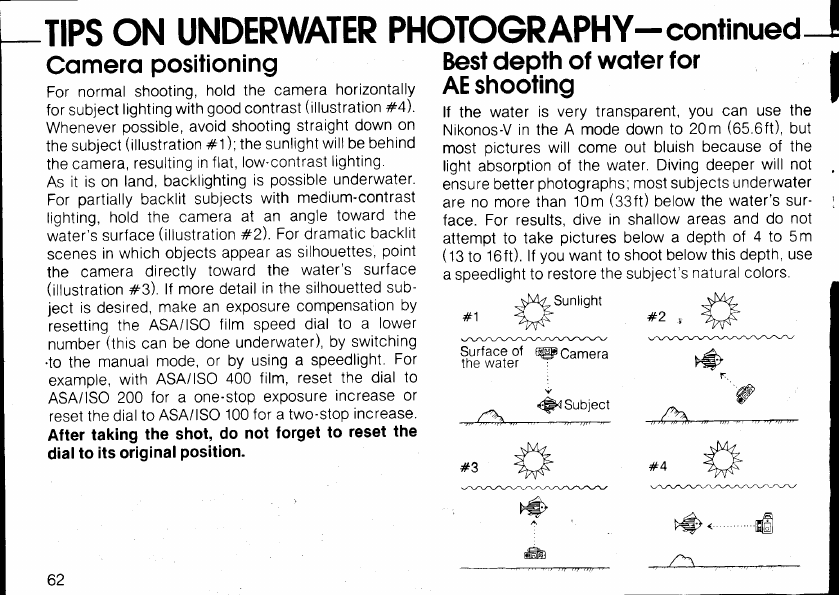
I-TIPS
ON
UNDERWATER
PHOTOGRAPHY-
continuedj
Comero
posilioning
For
normal
shooting,
hold the camera
horizontally
for
subject
lighting
witn
good
contrast
(illustration
+4).
Whenever
possible,
avoid
shooting
straight
down
on
the
subject
(illustration
#1),
the sunlight
will be
behind
the
camera,
resulting
in
f
lat,
low-contrast
lighting.
As
it is on
land,
backlighting
is
possible
underwater.
For
partially
backlit
subjects
with
medium-contrast
lighting,
hold the
camera
at an
angle
toward
the
water's surface
(illustration
*2).
For dramatic
backlit
scenes
in which
objects
appear
as silhouettes,
point
the
camera
directly
toward
the
water's
surface
(illustration
#3).
lf more
detail
in the
silhouetted
sub-
.lect
is desired,
make
an exposure
compensatlon
by
resetting
the
ASA/ISO
film speed
dial
to
a
lower
number
(this
can
be done
underwater),
by switching
.to
the
manual
mode,
or by
using
a speedlight
For
example,
with
ASA/lSO
400
film,
reset the dial
to
ASA/ISO
200
for a one-stop
exposure
increase
or
reset
the dial
to
ASA/lSO
'100
for a two-stop
increase'
After
taking
the shot,
do
not
forget
to
reset
the
dialto
its original
Position.
Best depth
of
woter
fol
AE shooting
lf
the
water
is
very transparent,
you
can use
the
Nikonos-V
in
the
A
mode down
to
20m
(65.6ft),
but
most
pictures
will come
out
bluish
because
of the
light absorption
of the
water.
Diving deeper
will not
ensure
better
photographs;
most subjects
underwater
are
no more
than
10m
(33ft)
below
the
water's sur-
face.
For results,
dive
in
shallow
areas
and do
not
attemot to take
oictures
below
a depth
of
4 to 5m
(tg
to
tOtt). lf
you
want to shoot
below
this depth,
use
a
speedlight
to
restore the subject's
natural colors.
_VMC
Sunlight
#1
fo.R
#2
Surface
of
rsga
Camera
lne waler
:
€.ffi
@
tu
$47
#4
4F
6
sroj""t
\447
#3
+F
rA
/q/
4
:
:
ffi@
o1


















